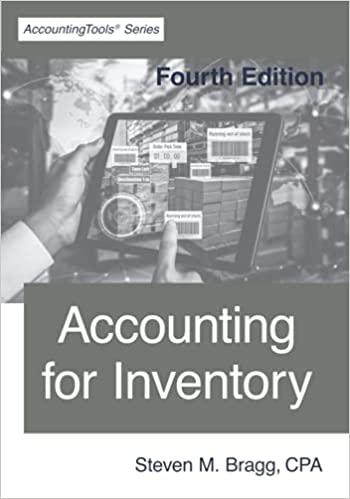Question
Step 1: From the comparative balance sheets, determine the increase in cash and cash equivalents during the year. Step 2: Prepare a T-account to show
Step 1: From the comparative balance sheets, determine the increase in cash and cash equivalents during the year.
Step 2: Prepare a T-account to show the transaction activity in each long-term balance-sheet account.
Step 3: Complete the statement of cash flows. From the income statement, take net income, depreciation, amortization, and the loss on sale of equipment to the statement of cash flows. Account for the year-to-year change in each balance sheet account.
PLEASE PROVIDE STEP BY STEP EQUATIONS and explanations (Use same format)!



GOOD LUCK!!! And thank you
Step 1: From the comparative balance sheets, determine the increase in cash and cash equivalents during the year. The increase in cash and cash equivalents during the year is $ 46,200 Step 2: Prepare a T-account to show the transaction activity in each long-term balance sheet account. For each plant asset, use a single account, net of accumulated depreciation (for example: Equipment, Net). Begin by posting the beginning balances to the T-accounts. Then, post the ending balances. Finally, record the transaction activity in each account, using the transaction letter identified in the listing provided below. (Be sure to select "Bal" to open and close the balances for each t-account. For accounts with a $0 beginning balance, make sure to select "Bal" and enter "0" on the normal balance side of the t-account) (Click the icon to view the T-account transaction data.) Long-Term Investments Bonds Payable 10,000 12,000 56,000 14,000 44,000 Bal d. 4,000 Bal Bal Bal Equipment, Net Common Stock Bal 17,000 1 Bal 60,000 1. 13,000 h. 24,000 a. 90,000 j. 76.000 C. 12,000 Bal 61,000 Bal 53,000 Patent, Net Retained Earnings Bal Bal 27,000 11,000 37,000 f. m. 4,000 b. 13,000 k. 39,200 Bal 44,000 Bal 53,200 Treasury Stock Long-Term Note Payable Bal g. Bal 9.000 9,000 37,000 55,000 15,000 1,000 f. e. Bal Bal 16,000 Step 3: Complete the statement of cash flows. From the income statement, take net income depreciation, amortization, and the loss on sale of equipment to the statement of cash flows. Account for the year-to-year change in each balance sheet account. Using the information given and the t-accounts completed in Step 2, complete the statement of cash flows one section at a time. Start by completing the cash flows from operating activities. Then complete each remaining section of the statement of cash flows. (Use parentheses or a minus sign for numbers to be subtracted and for a net decrease in cash.) 39,200 8.000 47,200 Joesph Company Statement of Cash Flows (Indirect Method) Year Ended December 31, 2018 Cash flows from operating activities: Net income Adjustments to reconcile net income to net cash provided by operating activities: Depreciation 13,000 Amortization 4,000 Loss on sale of equipment 2,000 Decrease in accounts receivable 2,000 Increase in inventories (9,000) Decrease in prepaid expenses 5,000 Increase in accounts payable 1,000 Decrease in accrued liabilities (10,000) Net cash provided by (used for operating activities Cash flows from investing activities: Purchase of equipment (90,000) Sale of equipment 74,000 Purchase of long-term Investment (4,000) Net cash provided by (used for) investing activities Cash flows from financing activities: Issuance of common stock 24,000 Payment of cash dividends (13,000) Issuance of long-term note payable 9,000 Purchase of treasury stock (1,000) Net cash provided by (used for) financing activities Net increase (decrease) in cash Cash balance, December 31, 2017 Cash balance, December 31, 2018 Noncash investing and financing activities: Issuance of long-term note payable to purchase patent Issuance of common stock to retire bonds payable Total noncash investing and financing activities (20,000) 19,000 S 46,200 3,000 $ 49,200 37,000 12,000 49,000 1 Income Statement - Balance Sheet Joesph Company Income Statement Year Ended December 31, 2018 $ 664.000 540.000 2018 2017 124.000 Assets Current Cash and cash equivalents Accounts receivable $ 34.000 $ 2.000 10.000 33,000 12,000 10,000 $ 46,000 13,000 Joesph Company Comparative Balance Sheets December 31, 2018 and 2017 2018 2017 Liabilities Current: Accounts payable $ 49,200 $ 3,000 Accrued liabilities 19.000 21,000 Income tax payable 46,000 37,000 Total current liabilities 2.000 7,000 Long-term note payable 116,200 68,000 Bonds payable 61,000 60,000 Stockholders' Equity 14,000 10,000 Common stock 44.000 11,000 Retained earnings Less: Treasury stock Total liabilities and Inventories 55,000 Sales revenue Cost of goods sold Gross profit Operating expenses Salary expenses Depreciation expense-equipment Amortization expense-patent Rent expense Total operating expenses Income from operations Other items: Loss on sale of equipment Income before income tax Income tax expense Net income 4,000 3,000 46.000 55,000 44,000 9,000 56,000 66,000 Prepaid expenses Total current assets Equipment, net Long-term investments Patent, net 58.000 17,000 53,000 53,200 (16,000) (2.000) 27,000 (15,000) 56.000 16,800 Total assets $ 235,200 $ 149,000 stockholders' equity $ 235,200 $ 149,000 39,200 Transaction Data 90,000 13,000 37,000 Transaction Data for 2018: Purchase of equipment with cash Payment of cash dividends Issuance of common stock to retire bonds payable Purchase of long-term investment with cash Purchase of treasury stock 12,000 Issuance of long-term note payable to purchase patent Issuance of long-term note payable to borrow cash Issuance of common stock for cash. Proceeds from sale of equipment (book value, $76.000) 9,000 24,000 4,000 1,000 74,000Step by Step Solution
There are 3 Steps involved in it
Step: 1

Get Instant Access to Expert-Tailored Solutions
See step-by-step solutions with expert insights and AI powered tools for academic success
Step: 2

Step: 3

Ace Your Homework with AI
Get the answers you need in no time with our AI-driven, step-by-step assistance
Get Started


